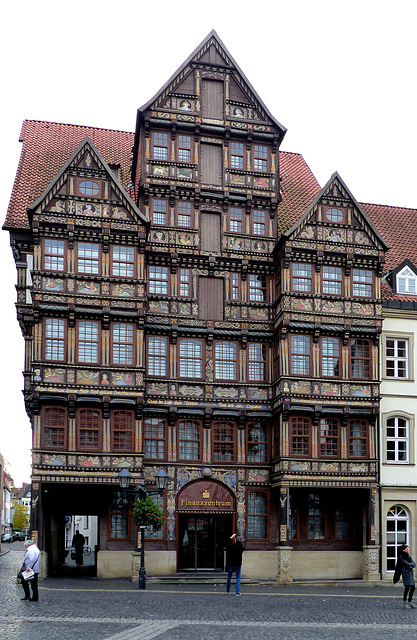Location
Lat, Lng: 52.152568, 9.951525
You can copy the above to your favourite mapping app.
Address: Rheinhessen Sparkasse Sparkasse
You can copy the above to your favourite mapping app.
Address: Rheinhessen Sparkasse Sparkasse
Keywords
Authorizations, license
-
Visible by: Everyone -
All rights reserved
-
119 visits
Hildesheim - Wedekindhaus


Louis the Pious founded the bishopric of Hildesheim in 815. The settlement developed into a town and was granted market rights by King Otto III in 983. Craftsmen and merchants were attracted and the city developed into an important community. By 1167, Hildesheim was an almost completely walled market settlement.
At the beginning of the 13th century, Hildesheim had about 5,000 inhabitants, and when Hildesheim received its city charter in 1249, it was one of the largest cities in northern Germany. The clergy ruled Hildesheim for four centuries before a town hall was built and the citizens gained influence and independence. In 1367, Hildesheim became a member of the Hanseatic League. But what is now called Hildesheim was various small "suburbs". After centuries of (sometimes armed) disputes, it was not until the end of the 16th century that a union was created and subsequently at least the inner wall was taken down Old and New Town.
During the Thirty Years' War, Hildesheim was besieged and occupied several times. In 1813, after the Napoleonic Wars, the town became part of the Kingdom of Hanover, which was annexed by the Kingdom of Prussia as a province after the Austro-Prussian War in 1866.
The air raids on Hildesheim in 1944/45 destroyed large parts of the city. Of the 1500 half-timbered houses, only 200 remained. 90 percent of the historic old town was destroyed in the firestorm.
-
The Wedekindhaus is a half-timbered house in Renaissance style on the south side of the market square. It was originally built in 1598 diagonally opposite the town hall by the merchant Hans Storre as a residential and commercial building.
The bombing of Hildesheim on March 22, 1945, resulted in the total destruction of the house. In the course of the overall reconstruction of the historic market square in the 1980s, the facade of the Wedekindhaus was reconstructed largely true to the original. Behind the facade, front is the connected new building of the headquarters of the Sparkasse Hildesheim.
At the beginning of the 13th century, Hildesheim had about 5,000 inhabitants, and when Hildesheim received its city charter in 1249, it was one of the largest cities in northern Germany. The clergy ruled Hildesheim for four centuries before a town hall was built and the citizens gained influence and independence. In 1367, Hildesheim became a member of the Hanseatic League. But what is now called Hildesheim was various small "suburbs". After centuries of (sometimes armed) disputes, it was not until the end of the 16th century that a union was created and subsequently at least the inner wall was taken down Old and New Town.
During the Thirty Years' War, Hildesheim was besieged and occupied several times. In 1813, after the Napoleonic Wars, the town became part of the Kingdom of Hanover, which was annexed by the Kingdom of Prussia as a province after the Austro-Prussian War in 1866.
The air raids on Hildesheim in 1944/45 destroyed large parts of the city. Of the 1500 half-timbered houses, only 200 remained. 90 percent of the historic old town was destroyed in the firestorm.
-
The Wedekindhaus is a half-timbered house in Renaissance style on the south side of the market square. It was originally built in 1598 diagonally opposite the town hall by the merchant Hans Storre as a residential and commercial building.
The bombing of Hildesheim on March 22, 1945, resulted in the total destruction of the house. In the course of the overall reconstruction of the historic market square in the 1980s, the facade of the Wedekindhaus was reconstructed largely true to the original. Behind the facade, front is the connected new building of the headquarters of the Sparkasse Hildesheim.
uwschu, Andy Rodker, Marco F. Delminho, kiiti and 2 other people have particularly liked this photo
- Keyboard shortcuts:
Jump to top
RSS feed- Latest comments - Subscribe to the comment feeds of this photo
- ipernity © 2007-2025
- Help & Contact
|
Club news
|
About ipernity
|
History |
ipernity Club & Prices |
Guide of good conduct
Donate | Group guidelines | Privacy policy | Terms of use | Statutes | In memoria -
Facebook
Twitter











Sign-in to write a comment.